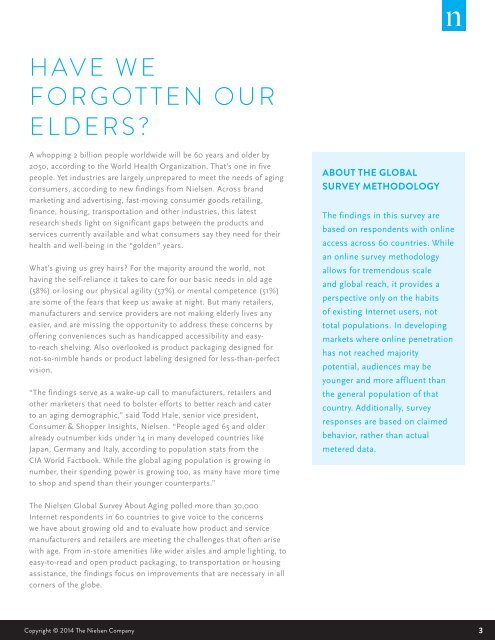nielsen-global-aging-report-february-2014
nielsen-global-aging-report-february-2014
nielsen-global-aging-report-february-2014
Create successful ePaper yourself
Turn your PDF publications into a flip-book with our unique Google optimized e-Paper software.
HAVE WEFORGOTTEN OURELDERS?A whopping 2 billion people worldwide will be 60 years and older by2050, according to the World Health Organization. That’s one in fivepeople. Yet industries are largely unprepared to meet the needs of <strong>aging</strong>consumers, according to new findings from Nielsen. Across brandmarketing and advertising, fast-moving consumer goods retailing,finance, housing, transportation and other industries, this latestresearch sheds light on significant gaps between the products andservices currently available and what consumers say they need for theirhealth and well-being in the “golden” years.What’s giving us grey hairs? For the majority around the world, nothaving the self-reliance it takes to care for our basic needs in old age(58%) or losing our physical agility (57%) or mental competence (51%)are some of the fears that keep us awake at night. But many retailers,manufacturers and service providers are not making elderly lives anyeasier, and are missing the opportunity to address these concerns byoffering conveniences such as handicapped accessibility and easyto-reachshelving. Also overlooked is product pack<strong>aging</strong> designed fornot-so-nimble hands or product labeling designed for less-than-perfectvision.“The findings serve as a wake-up call to manufacturers, retailers andother marketers that need to bolster efforts to better reach and caterto an <strong>aging</strong> demographic,” said Todd Hale, senior vice president,Consumer & Shopper Insights, Nielsen. “People aged 65 and olderalready outnumber kids under 14 in many developed countries likeJapan, Germany and Italy, according to population stats from theCIA World Factbook. While the <strong>global</strong> <strong>aging</strong> population is growing innumber, their spending power is growing too, as many have more timeto shop and spend than their younger counterparts.”ABOUT THE GLOBALSURVEY METHODOLOGYThe findings in this survey arebased on respondents with onlineaccess across 60 countries. Whilean online survey methodologyallows for tremendous scaleand <strong>global</strong> reach, it provides aperspective only on the habitsof existing Internet users, nottotal populations. In developingmarkets where online penetrationhas not reached majoritypotential, audiences may beyounger and more affluent thanthe general population of thatcountry. Additionally, surveyresponses are based on claimedbehavior, rather than actualmetered data.The Nielsen Global Survey About Aging polled more than 30,000Internet respondents in 60 countries to give voice to the concernswe have about growing old and to evaluate how product and servicemanufacturers and retailers are meeting the challenges that often arisewith age. From in-store amenities like wider aisles and ample lighting, toeasy-to-read and open product pack<strong>aging</strong>, to transportation or housingassistance, the findings focus on improvements that are necessary in allcorners of the globe.Copyright © <strong>2014</strong> The Nielsen Company3


